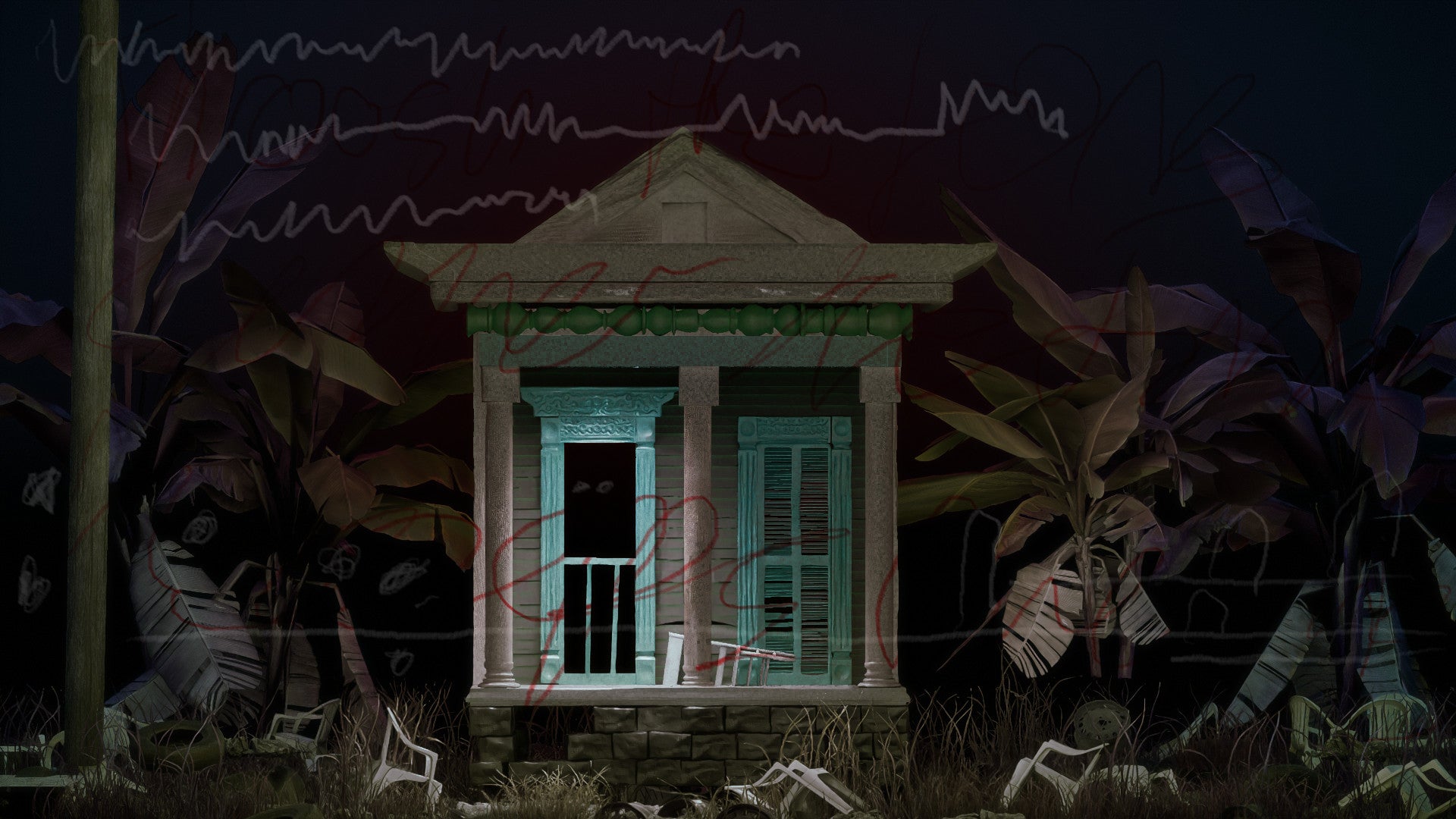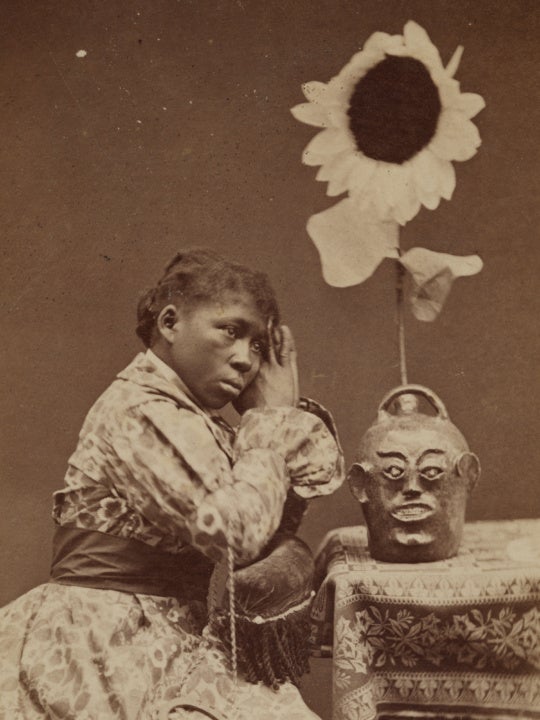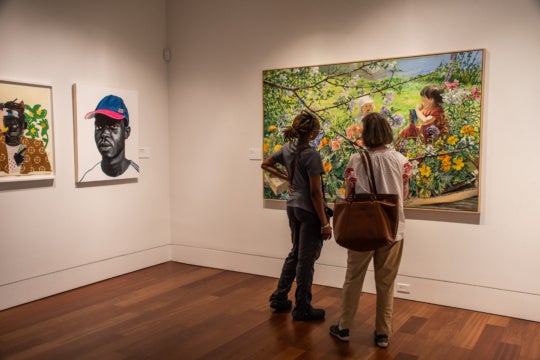
If you’re still intrigued by the Nathan Sharratt-Pastiche Lumumba feud, I present to you one more piece of the puzzle. Since I interviewed Pastiche Lumumba about his critique and wrote a summary response, it seemed only fair to give Nathan Sharratt the same opportunity to speak.
MATTHEW TERRELL: We’re here to discuss the controversy surrounding your MFA thesis exhibition at GSU, and Pastiche Lumumba’s critique of your work. Could you start off by giving us your side of the story?
NATHAN SHARRATT: It’s actually very nervewracking to speak about because he’s been so good at taking everything I say and twisting it.
I’m doing my MFA at Georgia State University, and I’m in my third year, so this year was about preparing for thesis and for exit. In the winter, I had a really bad depressive episode, where I wasn’t functioning, and I could barely leave the house, and I wasn’t getting things done, and I knew I had a lot of stuff to do. So I decided to ask for help and hire a studio assistant.
I put out an application on the Internet, saying that I had been sick and that I just needed some help to stay on track. I said that I would pay, but I couldn’t pay a full salary, so I would split between cash and other resources, like help with professional practices, access to my laser cutter, 3-D printer machines, things like that. So I wanted to do this half-internship, half-professional assistance-ship kind of thing.
I got a whole bunch of responses and Lumumba’s was one of the first. He was the first person I interviewed, and I thought he would be great. So, I hired him. I asked him if he was OK with the compensation package. He said he was. We started working and things were great for a little while, for a week or so. And then things started to slowly get weirder.
I was making work, and he was helping me make work. I was making the objects for my thesis show, and I was conceiving how the objects would relate to each other, what the story would be as I created the show. Then I had the problematic piece — the Nefertiti bust — which I was interested in because of its open source-ness, because of where it came from, because of the recent intervention by the artists [Nora Al-Badri and Jan Nikolai Nelles] that was purportedly a hoax. The blurring between truth and reality, and art and reality, I thought was very interesting for this. So I thought this would be a good representation of a historical object within this simulation that could bring up issues of colonialism, or issues of privilege, or issues of oppression — all those things.

When we talked about it, he said “this is a problematic piece.” And I said, “yes, I know. I’m building it that way. This is within a narrative. It’s a scene within a novel.” To my mind, it was a bad scene in a novel, but a scene that was important to the overall story. The same thing happened with the red Trump hat, which I altered to read “Make American Nate Again.” I was taking back that phrase from Trump, who’d taken it from Reagan.
We would have discussions about this, and I would try to explain to him that these are intentionally problematic issues that I want to talk about, because people don’t talk about them enough. I explained to him that these objects are part of a greater whole, that they’re within the context of the rest of the exhibition, that I’m going to have artwork titles, I’m going to have performances, I’m going to have all the virtual aspects, I’m going to have all these things built around them, like a novel.
So, Lumumba helped me install the show, and on the night of the opening, he stole one of the works. I didn’t know who took it. I went out into the lobby and asked if someone accidentally took it, and then I said that I was going to go check the security video footage. At that point, Lumumba was still in the lobby. The footage was pretty blurry, even though I was pretty sure it was Lumumba, some people weren’t, so I didn’t want to make any accusations. He didn’t take the problematic pieces, so I had a hard time figuring out why he would do it. Was he just mad that I didn’t censor the works? Was it some statement?
In the off-chance that it was some kind of performance art, I posted a message on Facebook saying, “Thanks everybody for coming out. Somebody took a piece, unfortunately. And this person is a member of the community.” I gave no names or identifying characteristics. I was going to allow multiple options for a resolution. So if this was part of his work, I was trying to give him an opportunity to say, “Here it is. Here’s a finished part of my work.” So I was just going to deal with it, and talk to him after the show. And then he posted his critique. And that’s where shit started getting really bad.
MT: Pastiche said that he did not expect this to go public. Do you believe that?
NS: Nope. Absolutely not. Maybe he didn’t intend for the initial act to become public, because it seemed really impulsive. But as soon as he posted his “Steal Nathan Sharratt” thing, he just saw an opportunity, I think, and ran with it. Then he just hijacked the entire thing, or tried to.

MT: Do you think he helped or hurt your MFA thesis exhibition?
NS: I think what played out is exactly what the exhibition was talking about. How we know what’s real, how we respond to what’s real, or not real. I think it hurt me, and I think it hurt other people. But it did help the exhibition because it validated what I was talking about. I was saying that I have difficulty determining what’s true and what’s not, like when I’m reading Facebook, when I’m looking on the Internet, when I’m going from news article to news article. It’s really hard to determine what’s true. That’s what the show, for me, was about, that disconnect between who I am as a person and who I am as an artist. They’re both real.
MT: How do you feel about the response from the community that said, “We can’t tell if this is a performance or not”?
NS: I get it. I get that initial question, because that’s a big part of my work.
MT: How do you feel about Pastiche Lumumba’s assertion that your work was recreating colonialist violence?
NS: I was genuinely shocked that he was not able to tell the difference between performance narrative and reality, especially after working with me. I was creating a character, and that character did some things that were not good, that were serious, that were issues that are very relevant to our social constructs today. He took that character out of context, and said, “This is real. The author is a murderer or a racist” or anything else that’s horrible that happens within the confines of this simulation.

MT: Do you think that using the Nefertiti bust and using the Trump slogan should be verboten for artists?
NS: No. I think artists should talk about whatever they want to talk about.
MT: What do you think about the quality of his institutional critique of you?
NS: I don’t think it was an institutional critique.
MT: Why not?
NS: Well, because I’m not an institution. He didn’t critique an institution. I was pretending to be one as an artist in a performance. But he attacked the artist. He attacked me, a fellow artist, and I’m not an institution. I’m a person. What gain is there other than his own raised standing in the community as a hard-hitting social justice warrior, or hard-hitting critic? He’s not a critic. I felt bullied.
MT: Was your statement an April Fool’s Day joke?
NS: Nope. It just happened to come out on April Fool’s Day because that’s when I finished it. I had a thesis committee meeting that morning. They read my statement, gave me suggestions, and I made those edits and then posted it.
When I “lie” in my work, I try to give a lot of clues that it’s a lie, or that it’s a performance, either by the language that I use, the fact that it’s completely appropriated from somewhere else, the distortions, the typos. I try to put in bread crumbs so that somebody looking at it can think about it and start to break it apart, and say, “Does this make sense in this context as actual reality? Or is this just a constructed reality?”
MT: How has your thesis committee responded?
NS: They suggested I follow through on my right to file charges, including for defamation. But I’m not going to press charges.
MT: What’s next?
NS: I think I’m going to start looking at a way to make a book from this exhibition, like an artist book. It was something I was thinking about before all this stuff happened. Now I think it’s definitely something I want to do: to make this into a narrative, or even a visual narrative, and all the things that happened around it. I’ve been documenting all of it. I’ve got hundreds and hundreds of screenshots of what people say, who says it, when they say it, what their responses are, how people choose to decide what’s real, and how they amplify what that thing is, whether it’s real or not.
MT: Do you have any final thoughts?
NS: The issues that he appropriated — oppression, privilege, institutional injustice — those are very real, very serious issues, and he minimized them to some sort of personal grudge. What does that mean for our community? A precedent has been set. I just hope we can learn from this and, in the future, maybe think a little bit more critically before we bring the pitchforks out.
My Two Cents
If you see art as a conversation about politics, then it totally seems like Sharratt is at fault. Pastiche Lumumba brought up great points about colonialism and how it was recreated in the context of Nathan Sharratt’s show. Blind to his own privilege, Sharratt re-perpetrated the same kind of colonialist violence on the Nefertiti bust that Nora Al-Badri and Jan Nikolai Nelles were commenting on.
But if you think art is a conversation about philosophy, then Sharratt mastered his intended concept. The Nefertiti bust scan may or may not have been real. Nathan Sharratt’s gallery show was a sardonic performance critique of institutional, economic, and academic structures. What was intended to be a precarious piece left the performative world and achieved its problematic platonic ideal.
Seeing the big picture, I’m not sure if Sharratt’s show deserved the pitchforked reaction it received. What played out perfectly encapsulates the worst of the Internet’s love of outrage and villainizing someone because of some deep-seated social injustice. Online shaming is our new form of public humiliation, and Sharratt got a big fat Scarlet Emoji with this show. For his part, Sharratt probably could have been more thoughtful and articulate about his position of social privilege, and how it related to the overall work. That would have diffused some of the situation, and he clearly made choices that caused this story to blow up. On the other hand, Lumumba used his privileged eloquence as ammunition against Sharratt, and moved a lot of people to hate Sharratt without understanding his work. Pastiche Lumumba definitely took the nuclear option, which was also a bit of self-promotion.
They’re both right, and they’re both wrong, and they’re both steamrolling each other. The most interesting part of this entire story is how it plays out like a meta-reality novel taking place in real life, online, and in the gallery. Every aspect of Nathan Sharratt’s show reflected the institutional absurdity of being a contemporary artist — even the takedown critique of the show by Lumumba reflects the absurd aspects of Internet vigilantism. I doubt this experience will hurt Nathan Sharratt’s career very much, because it seems like his work forces people to respond in a way that is quite novel. This whole thing is just a pissing contest in the wind, and when it’s over nobody’s going to be the winner.
GSU released this statement:
The Ernest G. Welch School of Art & Design at Georgia State University congratulates all of the 3rd Year MFA graduate candidates for their recent thought-provoking thesis exhibitions. The university is sensitive to the March 24th incident that stemmed from an artistic difference between attendee Pastiche Lumumba and MFA graduate candidate Nathan Sharratt during his thesis show, Nathan Sharratt’s show, Buy Nathan Sharratt: A Requirement of the Masters of Fine Arts Degree of Georgia State University. The university is consulting the police department to gather further information on the incidents, after which, we may or may not release a statement. In the meantime, the university continues to encourage artistic freedom along with vigorous debate, as a part of the MFA experience at Georgia State University.
Matthew Terrell writes, photographs, and creates videos in the fine city of Atlanta. His work can be found regularly on the Huffington Post, where he covers such subjects as the queer history of the South, drag culture, and gay men’s health issues. He was a participant in Cycle 2 of BURNAWAY’s Art Writers Mentorship Program.




